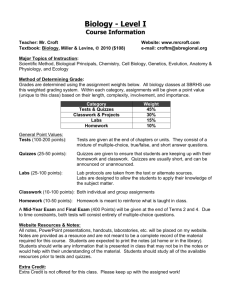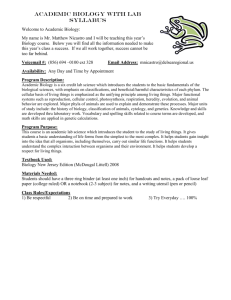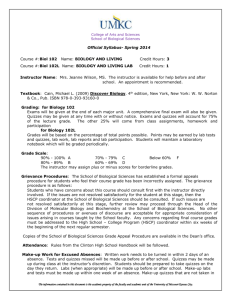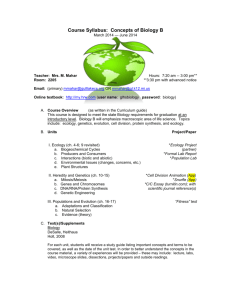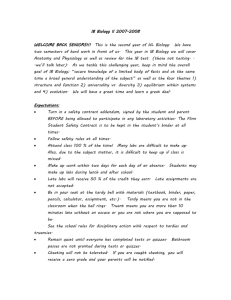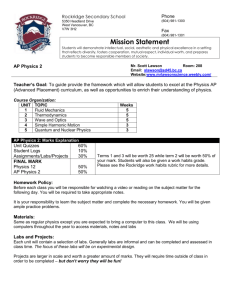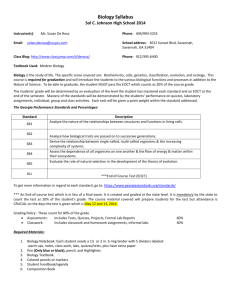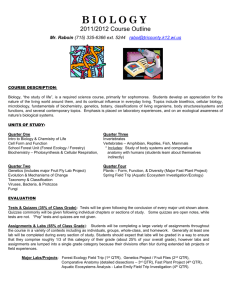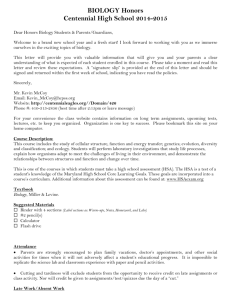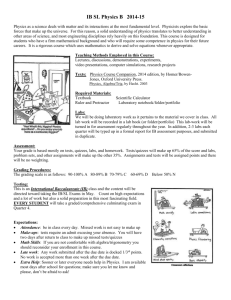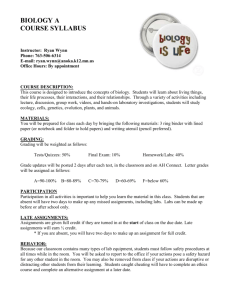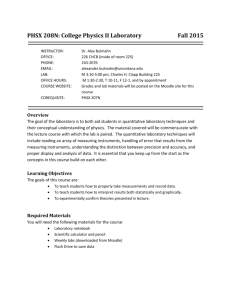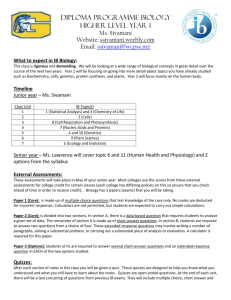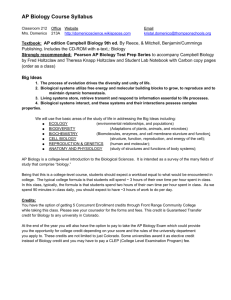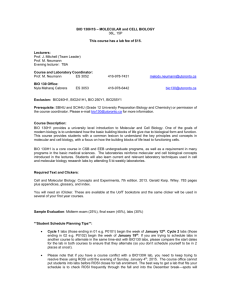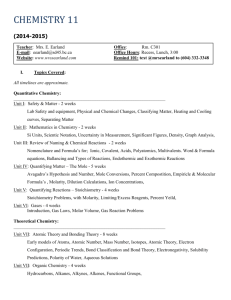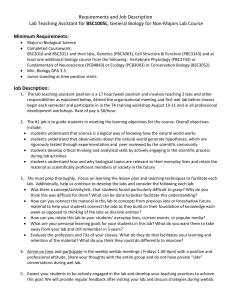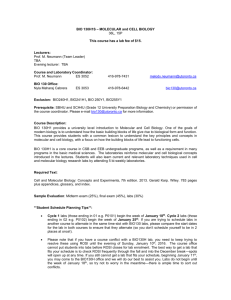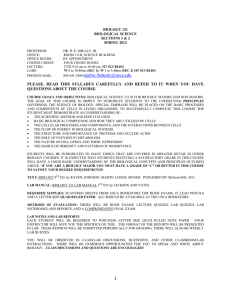BIO 105 Syllabus
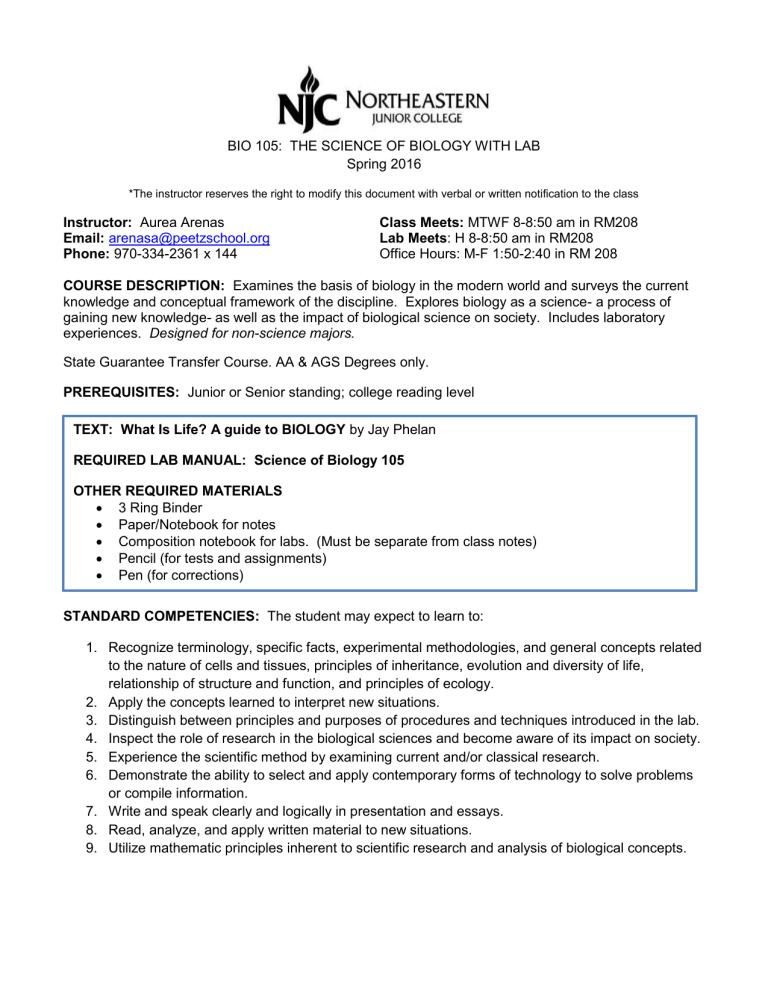
BIO 105: THE SCIENCE OF BIOLOGY WITH LAB
Spring 2016
*The instructor reserves the right to modify this document with verbal or written notification to the class
Instructor: Aurea Arenas
Email: arenasa@peetzschool.org
Phone: 970-334-2361 x 144
Class Meets:
Lab Meets
MTWF 8-8:50 am in RM208
: H 8-8:50 am in RM208
Office Hours: M-F 1:50-2:40 in RM 208
COURSE DESCRIPTION: Examines the basis of biology in the modern world and surveys the current knowledge and conceptual framework of the discipline. Explores biology as a science- a process of gaining new knowledge- as well as the impact of biological science on society. Includes laboratory experiences. Designed for non-science majors.
State Guarantee Transfer Course. AA & AGS Degrees only.
PREREQUISITES: Junior or Senior standing; college reading level
TEXT: What Is Life? A guide to BIOLOGY by Jay Phelan
REQUIRED LAB MANUAL: Science of Biology 105
OTHER REQUIRED MATERIALS
3 Ring Binder
Paper/Notebook for notes
Composition notebook for labs. (Must be separate from class notes)
Pencil (for tests and assignments)
Pen (for corrections)
STANDARD COMPETENCIES: The student may expect to learn to:
1. Recognize terminology, specific facts, experimental methodologies, and general concepts related to the nature of cells and tissues, principles of inheritance, evolution and diversity of life, relationship of structure and function, and principles of ecology.
2. Apply the concepts learned to interpret new situations.
3. Distinguish between principles and purposes of procedures and techniques introduced in the lab.
4. Inspect the role of research in the biological sciences and become aware of its impact on society.
5. Experience the scientific method by examining current and/or classical research.
6. Demonstrate the ability to select and apply contemporary forms of technology to solve problems or compile information.
7. Write and speak clearly and logically in presentation and essays.
8. Read, analyze, and apply written material to new situations.
9. Utilize mathematic principles inherent to scientific research and analysis of biological concepts.
TOPICAL OUTLINE:
I. Introduction
A. Nature of the Scientific Enterprise
B. Science and Society
C. Unifying Concepts
II. The Nature of Cells and Tissues
A. Cell Structure and Function
B. Energy Flow and Chemical Reactions
C. Cell Reproduction and Life Cycles
D. Tissues
E. Levels of Organization
III. Principles of Inheritance
A. Genetic Engineering
B. Human Genetics
IV. Evolution and Diversity of Life
A. Process and Products of Evolution
B. Microorganisms
C. Plants and Animals
V. Relationship of Structure and Function
A. Land Plants
B. Man and Other Animals
VI. Principles of Ecology
METHODOLOGY: Lectures are a mix of traditional lecture style and small group discussion and activities. The emphasis is on introducing and illustration new concepts and building on student knowledge. Labs are organized around both individual and small group activities. Introductory remarks in lab are kept at a minimum so that active student involvement is maximized. Individual assistance is the primary instructor/student contact in the laboratory.
DISABILITIES: It is the policy of Northeastern Junior College to provide appropriate accommodations to any student with a documented disability. If you have a need for accommodation in this course, please make an appointment to see me.
ATTENDANCE: You are expected to attend class. It is very difficult to do well in college if class time is missed. It is important to do homework every day. College courses require two hours of homework for each hour of class. It is your responsibility to sign the attendance sheet each day. Please be punctual.
This class will begin promptly at the assigned time. Tardiness will be disruptive to both the students and instructor. Students absent from lecture will be responsible for the material covered. It is the st udent’s responsibility to determine what was missed and obtain the notes or handouts.
BEHAVIOR: See to the classroom contract
STUDENTS RIGHTS AND RESPONSIBILITIES: See the student handbook
LABS: Lab is an important part of this course and will help clarify topics being covered in class. Lab exercises and handouts will be included on the chapter tests. Lab scores will account for at least onequarter of the final points. Lab assignments are to be read in advance. You should be prepared for lab each week. Grading will be based on quizzes, laboratory technique (safety, precision and cleanliness) and written reports. NO MAKE UP LABS ARE POSSIBLE (unless prearranged).
EVALUATION: Four tests will be given throughout each semester, along with a comprehensive final exam. Quizzes will also be given. Tests and quizzes may consist of multiple choice, true/false, matching, short answer, diagrams and essay. NO EXAMINATIONS WILL BE ALLOWED TO BE MADE
UP unless arrangements are made prior to the absence.
Failure to do so will result in a zero for the work missed.
** Cheating will not be tolerated and will result in a zero or may result in expulsion from the course
Your final grade will be based on test scores, quizzes, assignments and labs. There is no extra credit that you can request to raise your grade, but extra credit opportunities may exist. No late work will be accepted unless a documented emergency has occurred.
GRADING: The course grading will roughly consist of
1.
1. Quizzes: 25%
2. Tests: 50%
3. Labs: 25%
OVERALL COURSE LETTER GRADES:
Grades will be based on overall course percentage.
A = 90 – 100% of total points
B = 80 – 89% of total points
C = 70 – 79% of total points
D = 55 – 69% of total points
F = 54% and below of total points
Late lab reports will not be accepted.
Note: Labs, quizzes, and tests must be written in PENCIL (unless typed). Any of the assignments mentioned will automatically be deducted 10%. This will prevent any scribbling and scratching out work and contribute to legibility. If I cannot understand your writing or work, it will be considered incorrect.
Lab Reports
The key point in writing a lab report is to report your experiment and analysis to other people who have not done the experiment. You need to show why you did the lab (Objective), what you used
(Materials), what and how you did (Procedure), what you recorded (Data), what results you got
(Computation and Analysis), and how you thought about the lab (Conclusion). You are required to present your ideas clearly, logically, neatly, and shortly.
The composition book needs to have both your name and class on the cover
The first two pages will be reserved for a Table of Contents page, which will include the title of the labs and their page numbers.
Individual Lab Report Format:
1.
Title (2%) The name of the experiment, the date performed, and the name of your partner, if any
2.
Objective (5%) The purpose of the experiment and related methods
3.
Hypothesis (10%) A tentative
explanation
for observed phenomena. An “If … then…” statement may be used.
4.
Materials (3%) The equipment used
5.
Procedure (20%) A step-by-step description of the experimental procedure and related analysis
6.
Data (20%) Record all data neatly . Use tables to organize data. Tables must be properly labeled. Do not forget your units of measurement.
7.
Computation and Analysis (20%) Use the data obtained in the experiment to achieve the final results outlined in the objective part. Present your ideas, equations, and calculation procedure logically and shortly. Use tools such as graphs wisely.
8.
Conclusion (10%) Explain the data and results. Discuss whether the objective of the lab has been achieved or not. If some data and results are not good, explain why and/or propose methods how you can improve them.
9.
Legibility and Neatness (10%) Be aware that you are writing a scientific report for other people.
*A lab report example is available on the course website
HINTS ON PREPARING FOR EXAMS:
1. Don’t fall behind, because cramming doesn’t work.
2. Come to all class sessions. It is the rare person who can miss lectures and still do well on exams.
3. Collect questions and ask for clarification as you go along. The topics build so if you don’t understand today’s lecture. It will come back to haunt you.
4. Review regularly. If you review with a friend, structure your time around quizzing each other, and make sure you are trying to answer as many questions as you ask.
5. Read the text and compare it with the lectures. Take notes as you read. Watch all assigned videos and take notes on them. Use the CD ROM that came with your text.
6. Write out answers to the questions at the end of each chapter. Written answers stay with you longer.
Northeastern Junior College
BIO 105: THE SCIENCE OF BIOLOGY WITH LAB
Spring 2015
Important notes:
The last day to drop BIO 105 is January , 2016.
BIO 105 is covered in two semesters. You will not be able to drop the course at the end of the first semester.
If you earn a D or F in the course, you will be required to pay the tuition that is covered by
Peetz in the amount of _____________.
